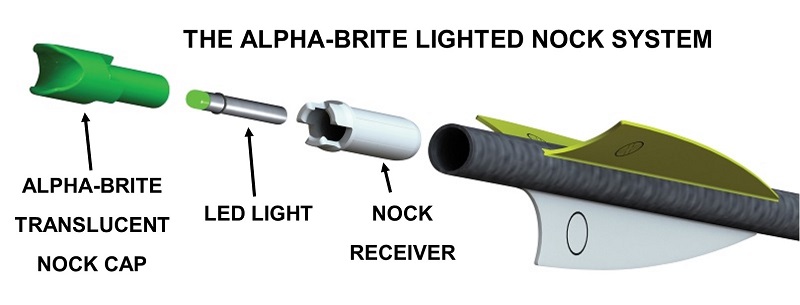The TenPoint Alpha-Nock: Pacing Modern Crossbow Performance and Design
TenPoint Crossbows / February 18th, 2019Advancing manufacturing and materials technology has combined with design innovations to radically transform the crossbow segment over the last decade. Greater launch velocities, decreasing axle-to-axle widths, and reverse-limb designs have significantly evolved the crossbow platform in recent years. Ancillary equipment, however, has not necessarily kept pace.
Consider the crossbow arrow nock.
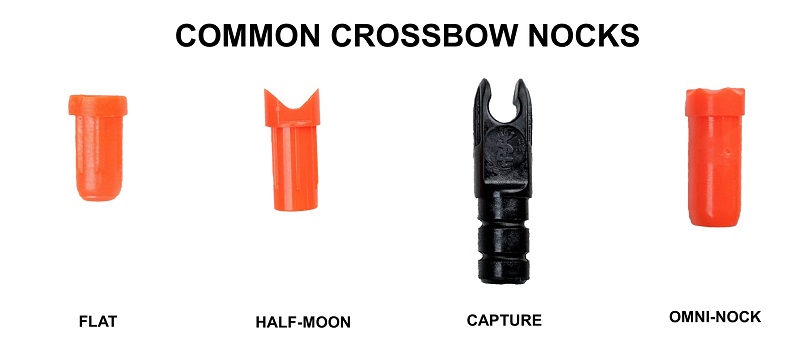
Nocks are dependent, as crossbow manufacturers and experienced shooters know, upon a bow’s design. Most manufacturers require a specific nock style for use in their crossbows. This is due in part to the trigger design, but larger contributors include the crossbow platform or launching system (rail/barrel platforms or free-float/rail-less systems) and the overall component dynamics, such as limb alignment, cam travel, riser configuration, and limb pocket design. All of these can lead to tolerance stacking issues (compounded deviations) that can further influence nock requirements and performance.
To better understand how the crossbow arrow nock can play a significant part in the overall performance of a crossbow, it is helpful to understand the progression of crossbow nock designs over the years and why their construction and designated use is critical to fulfilling a crossbow’s design performance.
Function of the Crossbow Nock
The crossbow nock is the interface between the crossbow string and the arrow. Its purpose is to maintain a solid, centered contact surface between the two from the moment the crossbow trigger releases the string until the string pushes the arrow beyond the length of string travel. There are two critical aspects within this process that is the responsibility of the nock.
First, the nock must ensure center alignment of the string to the back of the shaft throughout the launch cycle. This is necessary for the arrow to launch from the flight deck or arrow rest in a precise and predictable manner in order to achieve accuracy (repeatable point-of-impact). A nock that does not maintain a centered string-to-shaft alignment throughout the launch cycle can promote misalignment of the arrow axis relative to the intended flight path. This produces inconsistencies in accuracy and can reduce the arrow’s kinetic energy since energy must now be wasted to correct arrow instability in flight.
The second, and arguably most important, function of the nock is to ensure it maintains contact with the string throughout the launch cycle to prevent a dry-fire or partial dry-fire condition caused by the string shooting over or under the nock.
Arrows absorb the massive amount of energy stored in a cocked crossbow upon release of the string. If the nock fails to maintain string-to-arrow engagement throughout the launch cycle—such as when the string overrides or under-rides the arrow during launch—the result can be a catastrophic failure of the crossbow. This can happen because crossbows (as with vertical bows) are engineered with parameters that include the arrow absorbing a threshold of energy stored by the crossbow. Should the arrow fail to absorb its intended share of energy, that unused energy is transmitted back to the crossbow, with the result being potential component failure and possibly serious injury to the shooter.
Crossbow Arrow Nock Evolution
The Flat Nock
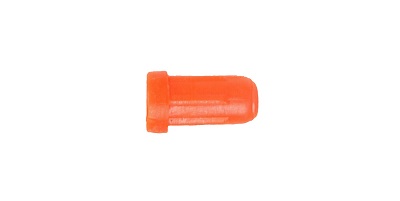
The oldest, and most basic string-to-arrow interface is a flat surface perpendicular to the back of the arrow. The advent of tubular shafts required an insertable nock to serve this purpose. Centuries after the development of the crossbow, this flat nock design is still in use today. Flat nocks are simply an even surface at the back of the arrow that allows the string to apply mechanical force to the arrow and launch it from the crossbow. As such, it offers no assurance of precise string-to-arrow alignment during launch and its ability to resist the string’s potential for overriding or under-riding the nock relies solely on the string delivering precise travel alignment throughout the launch cycle.
An advantage of the flat nock is its consistent, non-indexed surface area. This means that the arrow can be installed in any vane orientation, eliminating the possibility of being incorrectly oriented on the crossbow’s flight deck. This same design feature is also a disadvantage since the lack of positive indexing combined with a round surface (the crossbow serving) pushing against a round edge (the outside diameter of the flat nock) can influence an override or under-ride condition in some situations. Another disadvantage to the flat nock is its relatively sloppy string engagement, which can reduce accuracy. It also can’t be used on a rail-less crossbow design.
The Half-Moon Nock

With the progression of faster, more compact crossbows and variations in trigger systems and rail designs from the crossbow manufacturers came the next step in crossbow arrow nock evolution—the half-moon nock. The half-moon nock features a relatively shallow and wide concave groove inside of an otherwise conventional flat nock. The design intent of this nock was to provide a way to ensure the crossbow string seated in the nock upon trigger release and stayed with the arrow’s axis throughout the launch cycle. The need for string-to-nock groove alignment, however, mandated that the arrow be correctly indexed when placed onto the flight deck. Failure to do so would likely result in a dry-fire or partial dry-fire of the crossbow.
The half-moon nock represented a much-needed advancement in crossbow arrow nock design, however, the flat engagement surface at the base of the groove and the shallow, wide groove still allowed for inconsistencies in arrow alignment during the launch cycle, leading to inconsistencies in accuracy under certain conditions. This design, as used today, creates a “wedge” groove contact to the string, with sharp edges and sides. Modern high-performance crossbows can split the wedge open under force. This is why some moon nocks are now made of metal.
Capture/Full-Containment Nock
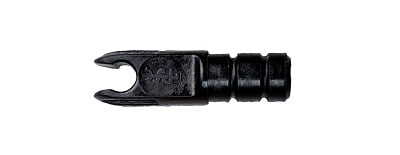
As crossbow axle-to-axle widths became shorter and the stored energy capacity of crossbows increased, positive string engagement became more critical. The solution was to modify the half-moon nock concept, creating a nock more similar in profile and function to that of conventional vertical bow nocks. As such, the capture-style and full containment nocks (nocks that snap onto the string) feature longer “ears” than those afforded by moon nocks and include a deeper string groove.
For accuracy, the capture nock offers an advantage over the flat and half-moon nocks because vertical travel of the string relative to the arrow axis is eliminated. The flat engagement surface of the nock’s groove, however, meant that horizontal movement of the arrow, albeit slight, was still possible.
Although the capture-style nock certainly improved string engagement and shot reliability, variations in trigger designs, release dynamics, and even the configuration of the dry-fire inhibitor across various manufacturers meant that not all crossbows could shoot arrows fitted with these nocks. These nocks still have flat surfaces and corners where the string contacts the nock. Center serving diameter is critical to fit and poses a problem among different string manufacturers or serving materials. Servings tend to get smaller in diameter with use. This causes the fit to the nock to change over time.
Multi-Groove (Omni) Nock
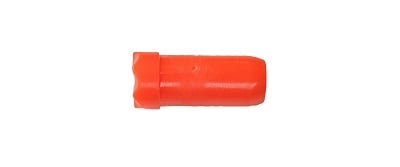
The biggest leap forward in crossbow arrow nock design came with introduction of the multi-groove hybrid nock, or Omni-Nock, engineered by TenPoint Crossbow Technologies. Capitalizing on the benefits of the non-indexed flat nock while incorporating the string-capturing performance of the half-moon and capture-style nocks, the Omni-Nock solved the various problems associated with the preceding nock designs.
By incorporating six string alignment grooves (for the three string positions relative to vane alignment) into a convex nock profile, the Omni-Nock fully engaged the string regardless of the arrow’s orientation on the flight deck. Additionally, the unique convex profile allowed the nock to better match the natural curvature of the string along the nock engagement surface. This profile eliminated the vertical and/or horizontal string slop inherent to the squared engagement surfaces of conventional flat, half-moon, and capture-style nocks, ensuring a more positive arrow-to-string engagement throughout the launch cycle and thus improved accuracy.
NEEDED: A New Nock for the Modern Crossbow Generation
Napoleon learned during his Russia campaign that bad things happen when an army outpaces its logistic support. That is analogous to where we are today with the crossbow segment. Faster, quieter, and more compact crossbows deliver on their promise of better performance and greater mobility, yet the rest of the equation hasn’t exactly kept pace. Conventional crossbow arrow nocks, especially, have not adequately supported the performance of many of the bows that launch them.
Two aspects of today’s leading crossbows have resulted in this performance disparity—narrowing axle-to-axle widths and higher crossbow velocities. With crossbow velocities surpassing 400 FPS and cocked axle-to-axle widths as narrow as six to seven inches, the nock’s role in making the difference between a successful shot or catastrophic failure has never been more important.
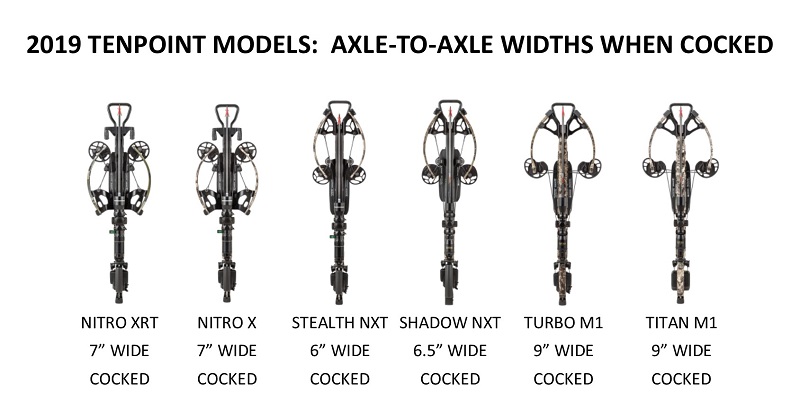
For a crossbow arrow nock to ensure a safe arrow launch in today’s high-velocity, acute string angle crossbows, it must be able to accomplish three key tasks:
- Withstand launch thrust or string impact
- Establish full engagement with the string
- Maintain engagement with the string throughout the launch cycle
The ability of the nock to withstand string impact is dependent on both the nock’s design and its material construction. The abrupt application of force from today’s high-energy crossbows against the nock requires a nock that does not promote cracking or distortion—particularly in the groove or along the ears (such as in capture/full-containment nocks). This condition has been observed in some nocks propelled by high-velocity crossbows—especially those with a slotted channel deep in the string groove. That is because sharp angles within a nock groove can present sheering planes that could lead to potential structural failure when applied force exceeds the nock’s design or material parameters.
Establishing and maintaining string engagement with the nock from trigger release through arrow launch is also essential for safety and is an even greater challenge as string angles become more acute (due to shorter axle-to-axle widths) and string velocities increase. For these reasons, it is critical that a nock used with short-axle, high-velocity crossbows captures the string and maintains its positive engagement throughout the launch cycle—something most conventional nocks cannot guarantee in all conditions, such as when an arrow is misaligned on the flight deck or is not fully seated against the string. While this is true for all crossbows, such alignment issues are compounded when dealing with the more acute string angles and higher string velocities.
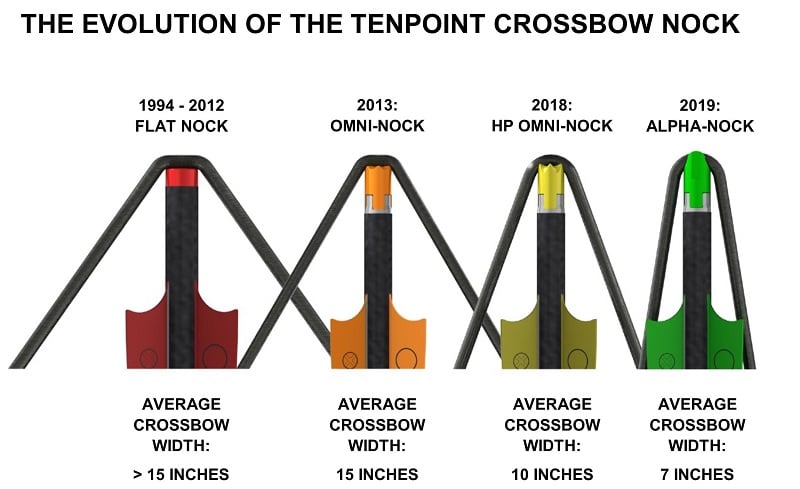
Aside from the nock’s critical safety role, the nock also influences bow performance—something that, again, is compounded by today’s shorter-axle, higher-velocity crossbows. Taking material construction and design integrity (the ability to withstand launch forces and dynamics) out of the equation, optimal nock performance comes down to the ability to engage the string. Improper nock-to-string engagement on a modern high-performance crossbow is:
- Detrimental to accuracy – Anything less than full contact of the string and nock radii can introduce misalignment issues that cause the arrow to move off-axis during launch, resulting in inconsistent flight characteristics and reduced accuracy potential.
- Detrimental to string longevity – The more movement between the string and the nock during the launch cycle the greater the wear on the string serving. Sharp edges on nocks shot from short-axle crossbows can also promote string serving wear.
- Detrimental to noise mitigation – Gaps or inconsistencies in the nock-to-string engagement surface can cause the arrow to act like a “loose bolt” during launch, elevating vibration noise.
- Detrimental to energy transfer – Lacking full string-to-nock surface engagement, not all potential stored energy is transferred to the arrow, meaning it must be reabsorbed by the crossbow. That unused energy translates to increased vibration that can have a long-term impact on component wear.
Introducing the Alpha-Nock™
As the leading developer and manufacturer of crossbow technology, TenPoint realized that a new nock was needed to meet the technological and performance thresholds of today’s most advanced crossbows.
Mindful of the lessons learned over the last couple decades with the progression of crossbow arrow nocks, TenPoint’s engineers set out to develop a nock that addressed all the shortcomings of previous designs while delivering on the performance needs of the short axle-to-axle width, high-velocity crossbows on the market today and into the future. This established the roadmap for developing a nock ideally suited not only for the ultra-compact high-performance crossbows, but also for nearly all crossbow designs past through the present. The result is the TenPoint Alpha-Nock™.
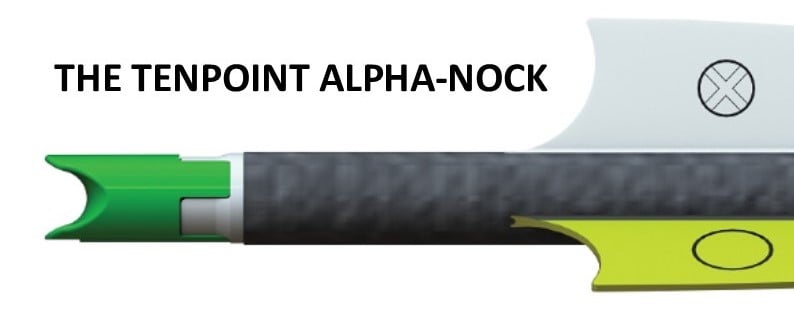
The Alpha-Nock™ is an indexed-style nock system that incorporates a receiver that inserts into the shaft and a nock that inserts into the receiver. As such, the system aligns with the arrow vanes, allow the nock to be placed perpendicular to whichever vane yields the optimal accuracy during shot-group testing.
The critical aspects of the Alpha-Nock™, however, are found in the nock throat. The string groove is deeper than a conventional half-moon nock, with steeper angles along the ears to ensure no-fail alignment of the string upon trigger release and throughout the launch cycle. In other words, the concave string engagement groove engulfs the string to ensure positive engagement.
In addition to the concave groove profile, the Alpha-Nock™ features a convex surface at the back of the nock throat. This contrasts with most conventional nocks that have a flat groove throat. The convex profile matches the contour of the string serving—even the extremely acute angles of short axle-to-axle width crossbow strings—to provide an increase in string-to-nock engagement of up to 28% over older nock designs regardless of string diameter. This profile delivers on several important performance and safety factors:
- First, the maximum surface engagement ensures straight nock travel along the flight deck for greater downrange accuracy.
- Second, the deep nock groove prevents the string from overriding or under-riding the nock.
- Third, the string-friendly radius significantly reduces serving wear.
- Fourth, the positive engagement means improved energy transfer to the centerline of the arrow, reducing energy waste that might contribute to additional noise or vibration.
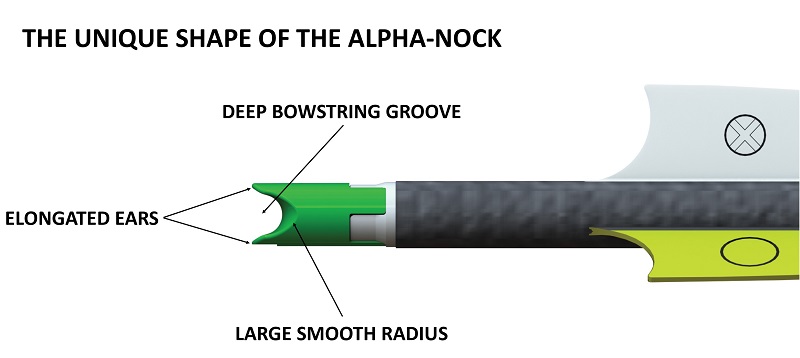
In sum, arrows launched with the Alpha-Nock™ fly straighter, string wear is minimized, there is optimal containment and engagement across most crossbow launch systems, and maximum available energy is transferred to the arrow for improved downrange penetration.
Alpha-Nock™ Applications
Beginning with the 2019 model year, all TenPoint crossbows will require the use of the Alpha-Nock™ as the manufacturer standard.
The Alpha-Nock™, however, is also compatible with all earlier-model TenPoint and all earlier and current Horton and Wicked Ridge crossbows regardless of their axle-to-axle width. Furthermore, the Alpha-Nock™ is compatible with most other-brand crossbows that utilize rail or barrel-type launch platforms, also regardless of their axle-to-axle width. The exceptions are crossbows featuring free-float/rail-less launch systems that require the older or uniquely-designed capture-style nocks.
Understanding the desire of crossbow hunters for, and the significant advantages of shooting, lighted nocks, TenPoint also developed the Alpha-Brite™ Lighted Nock System. This system utilizes the same nock and receiver profile of the Alpha-Nock™ but incorporates an LED light stick that activates upon arrow launch to better track arrows in flight and to assist in post-shot recovery efforts. As with the Alpha-Nock™, the Alpha-Brite™ Lighted Nock System works with the aforementioned crossbow applications, excluding those featuring free-float/rail-less launch systems that require the older or uniquely designed capture-style nocks.
